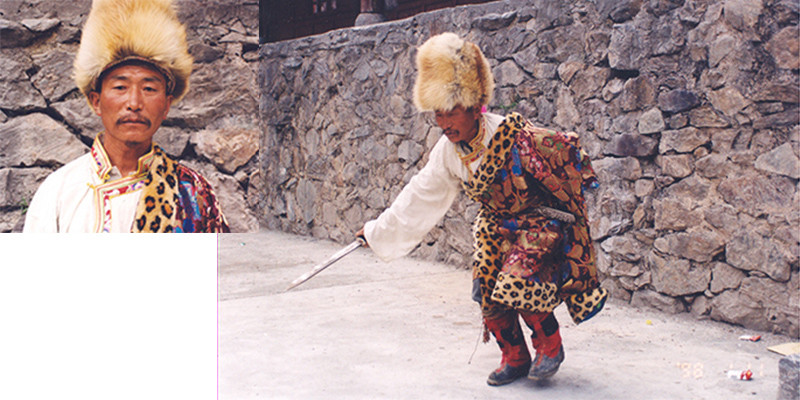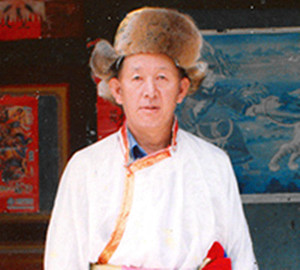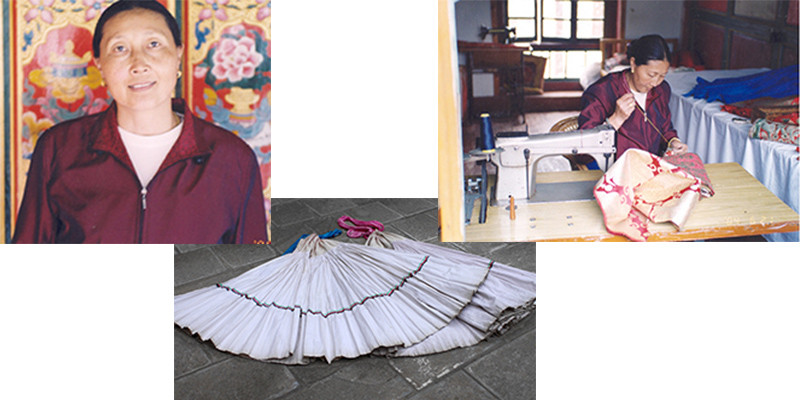Tibetan Ethnic Minority
The Tibetan population of Yunnan Province is 140000, mainly living in Diqing Tibetan Autonomous Prefecture, with a small number scattered in Yulong, Gongshan, Yongsheng, Ninglang and other counties. Tibetan culture is rich and colorful, with its own language and characters. They believe in Tibetan Buddhism and regard white as a symbol of sanctity. They live in compact community in mostly highlands and mountainous country studded with snow-capped peaks, one rising higher than the other. History of Tibetan Ethnic Minority The Tibetans first settled along the middle reaches of the Yarlung Zangbo River in Tibet. Evidence of the new and old stone age culture was found in archaeological excavations at Nyalam, Nagqu, Nyingchi and Qamdo. According to ancient historical documents, members of the earliest clans formed tribes known as “Bos” in the Shannan area. In the 6th century, the chief of the Yarlung tribe in the area became leader of the local tribal alliance and declared himself the “Zambo” (king). At the beginning of the 7th century, King Songzan Gambo began to rule the whole of Tibet and made “Losha” (today’s Lhasa) the capital. From the 10th to 12th century, Tibet fell apart into several independent regimes and began to move towards serfdom. The Yuan Dynasty (1279-1368) founded by the Mongols in the 13th century brought the divided Tibet under the unified rule of the central government. Areas inhabited by Tibetans were liberated one after another after the founding of the People’s Republic of China in 1949. Tibet proper was liberated peacefully in 1951. In addition, autonomous prefectures, autonomous counties and autonomous townships have been established in the southwest and northwest Tibetan areas. Distribution of Tibetan Ethnic Minority in Yunnan Tibetan Autonomous Prefectures in Yunnan
Local Tibetan Villages in Yunnan
Luotong Village in Weixi County, Diqing Cigulu Village in Shangrila, Diqing Hamugu Village in Shangrila, Diqing Napa Village in Shangrila, Diqing Xiagei Village in Shangri-la, Diqing
Protection Area of Tibetan Ethnic Culture
Benzilan Village Tibetan Ethnic Culture Protection Area in Deqin County, Diqing
Ethnic Culture of Tibetan Ethnic Minority Religion Most Tibetans generally observe Tibetan Buddhism or a collection of native traditions known as Bön (also absorbed into mainstream Tibetan Buddhism). There is a minority Tibetan Muslim population. There is also a small Tibetan Christian population in the eastern Tibet and northwestern Yunnan of China. Also there are some Tibetan Hindus who mainly live in China, India and Nepal. Tibetans places Mani stones prominently in public places, which play a major role in the lives of the Tibetan people, conducting religious ceremonies and taking care of the monasteries. Pilgrims plant prayer flags over sacred grounds as a symbol of good luck. The prayer wheel is a means of simulating the chant of a mantra by physically revolving the object several times in a clockwise direction. Tibetan Buddhists chant the prayer “Om mani padme hum”, while the practitioners of Bön chant “Om matri muye sale du”. Language The Tibetic languages are a cluster of mutually unintelligible Sino-Tibetan languages spoken by approximately 8 million people, primarily Tibetan, living across a wide area of eastern Central Asia bordering the Indian subcontinent, including the Tibetan Plateau and Baltistan, Ladakh, Nepal, Sikkim, and Bhutan the northern Indian subcontinent. Classical Tibetan is a major regional literary language, particularly for its use in Buddhist literature. The Central Tibetan language, Khams Tibetan, and Amdo Tibetan are generally considered to be dialects of a single language, especially since they all share the same literary language, while Dzongkha, Sikkimese, Sherpa, and Ladakhi are generally considered to be separate languages. Although some of the Qiang peoples of Kham are classified by China as ethnic Tibetans, the Qiangic language are not Tibetic, but rather form their own branch of the Sino-Tibetan language family. Life Tsampa, yak butter tea and Tibetan barley wine are the staple food for Tibetan people. People also like dairy products and air-dried beef and mutton. Castle-like house is the most representative one in Tibet. They are often stone-wood structure of primitive simplicity, looking dignified and stable. In the pasturing area, people usually live in a yak hair tent. The tent is usually square-shaped supported by eight upright pillars. Generally speaking, they wear short upper garment made of silk or cloth with long sleeves inside, wide and loose robe outside and long boots of cattle hide. Tibetans deem Hada as the most precious gift, which is a strip of snow-white scarf made of yarn or silk, symbolizing goodwill and respect, as well as festivity, arrival and departure of guests, etc. Polyandry is practiced in parts of Tibet. However, monogamy is more common throughout Tibet. Cultural Heritages of Tibetan Ethnic Minority in Yunnan Intangible Cultural Heritages of Tibetan in Yunnan
Sacrificial Ceremony to Meili Snow Mountain Shenchuan Reba Dance in Weixi County, Diqing Sinong Reba Dance in Deqin County, Diqing Reba Dance of Tibetan Ethnic Minority
Inheritors of Tibetan Intangible Cultural Heritages in Yunnan
Zhaxi Wenbu – Tibetan Rap Art Gema Zhadui – Engraver of Tibetan Scripture Ge Rong – Tibetan Wooden Bowl-making Craft Zhuo Ma – Tibetan Costume Maker Zha Ba – Tibetan Xianzi Dance Bai Niu – Xianzi-playing Skill Liao Wenhua – Wooden Bowl-making Craft Xie Liang – Wooden Bowl-making Craft He Qiankun – Tibetan Silver Ornament-making Craft Guo Jianhua – Pottery-making Craft Zha Xi – Tibetan Folk Handicrafts Sunnuo Qilin – Black Pottery Firing Techniques Dazhen Qupi – Tibetan Guozhuang Dance Xu Guilian – Tibetan Guozhuang Dance Guo Junhua – Tibetan Black Pottery Firing Techniques Project Lurong Gedeng – Color Painting and Mask-making Skill
Festivals of Tibetan Ethnic Minority in Yunnan
Shugu Nisu Festival or Fertilization Festival Gedong Festival in Shangri-La City, Diqing Dengba Festival in Shangri-La City, Diqing Xianzi Festival in Deqin County, Diqing Arrow Shooting Festival in Deqin County, Diqing Molang Qinbo Festival in Deqin County, Diqing Holy Mountain Festival in Deqin County, Diqing Horse Racing Festival in Shangri-La, Diqing The Pilgrimage of Kawa Karpo Kora in Diqing
See more about Festivals of Tibetan Ethnic Minority.

 7 Days GolfingTour
7 Days GolfingTour
 8 Days Group Tour
8 Days Group Tour
 8 Days Yunnan Tour
8 Days Yunnan Tour
 7 Days Shangri La Hiking
7 Days Shangri La Hiking
 11 Days Yunnan Tour
11 Days Yunnan Tour
 6 Days Yuanyang Terraces
6 Days Yuanyang Terraces
 11 Days Yunnan Tour
11 Days Yunnan Tour
 8 Days South Yunnan
8 Days South Yunnan
 7 Days Tea Tour
7 Days Tea Tour
 8 Days Muslim Tour
8 Days Muslim Tour
 12 Days Self-Driving
12 Days Self-Driving
 4 Days Haba Climbing
4 Days Haba Climbing
 Tiger Leaping Gorge
Tiger Leaping Gorge
 Stone Forest
Stone Forest
 Yunnan-Tibet
Yunnan-Tibet
 Hani Rice Terraces
Hani Rice Terraces
 Kunming
Kunming
 Lijiang
Lijiang
 Shangri-la
Shangri-la
 Dali
Dali
 XishuangBanna
XishuangBanna
 Honghe
Honghe
 Kunming
Kunming
 Lijiang
Lijiang
 Shangri-la
Shangri-la
 Yuanyang Rice Terraces
Yuanyang Rice Terraces
 Nujiang
Nujiang
 XishuangBanna
XishuangBanna
 Spring City Golf
Spring City Golf
 Snow Mountain Golf
Snow Mountain Golf
 Stone Mountain Golf
Stone Mountain Golf













